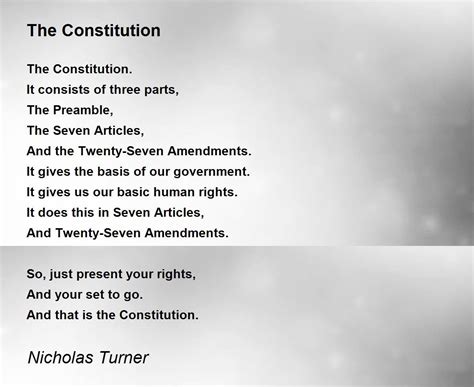What Is A Constitutional Government

A constitutional government is a system of governance where the power of the government is limited by a constitution, which outlines the framework, principles, and powers of the government. This type of government is designed to protect the rights and freedoms of citizens, while also promoting stability, accountability, and the rule of law. The concept of constitutional government has evolved over time, with ancient civilizations such as Athens and Rome laying the groundwork for modern constitutional systems.
In a constitutional government, the constitution serves as the supreme law of the land, taking precedence over all other laws and government actions. This document typically establishes the structure and powers of the government, including the executive, legislative, and judicial branches, as well as the relationship between the government and the citizens. The constitution also outlines the fundamental rights and freedoms of citizens, such as freedom of speech, assembly, and the press, which are protected from government infringement.
Key Points
- A constitutional government is a system of governance where power is limited by a constitution.
- The constitution outlines the framework, principles, and powers of the government.
- Constitutional governments protect the rights and freedoms of citizens, promoting stability and accountability.
- The constitution serves as the supreme law of the land, taking precedence over all other laws and government actions.
- Fundamental rights and freedoms, such as freedom of speech and assembly, are protected from government infringement.
Characteristics of Constitutional Governments

Constitutional governments are characterized by several key features, including the separation of powers, checks and balances, and the protection of individual rights and freedoms. The separation of powers refers to the division of power among the executive, legislative, and judicial branches, which helps to prevent any one branch from becoming too powerful. Checks and balances, on the other hand, refer to the mechanisms that allow each branch to limit the actions of the other branches, preventing abuse of power.
In addition to these features, constitutional governments are also characterized by their commitment to the rule of law, which holds that all individuals, including government officials, are subject to the law and must obey it. This principle helps to promote stability, predictability, and fairness in the application of the law. Furthermore, constitutional governments often have an independent judiciary, which plays a crucial role in interpreting the constitution and ensuring that government actions are consistent with its provisions.
Separation of Powers
The separation of powers is a fundamental principle of constitutional governments, as it helps to prevent the concentration of power in any one branch of government. In a system with separate branches, each branch has distinct powers and responsibilities, which are designed to check and balance the actions of the other branches. For example, the legislative branch may have the power to make laws, while the executive branch has the power to enforce them, and the judicial branch has the power to interpret them.
| Branch of Government | Powers and Responsibilities |
|---|---|
| Legislative | Makes laws, approves presidential appointments, controls government spending |
| Executive | Enforces laws, serves as commander-in-chief, conducts foreign policy |
| Judicial | Interprets laws, decides cases, declares laws unconstitutional |

Types of Constitutional Governments

There are several types of constitutional governments, including monarchies, republics, and federal systems. In a monarchy, a king or queen serves as the head of state, while in a republic, the head of state is typically an elected president or prime minister. Federal systems, on the other hand, divide power between a central government and smaller regional governments, such as states or provinces.
Each type of constitutional government has its own strengths and weaknesses, and the choice of system often depends on the specific needs and circumstances of a country. For example, federal systems can provide greater autonomy to regional governments, while monarchies can provide a sense of stability and continuity. Ultimately, the type of constitutional government that is best suited to a country will depend on its unique history, culture, and values.
Federal Systems
Federal systems are a type of constitutional government that divides power between a central government and smaller regional governments. In a federal system, the central government typically has the power to make laws and policies that apply to the entire country, while the regional governments have the power to make laws and policies that apply only to their specific region. This division of power can provide greater autonomy to regional governments, while also promoting national unity and cooperation.
Examples of federal systems include the United States, Germany, and Australia. In each of these countries, the central government has the power to make laws and policies that apply to the entire country, while the regional governments have the power to make laws and policies that apply only to their specific region. This division of power can help to promote regional autonomy, while also promoting national unity and cooperation.
What is the main purpose of a constitutional government?
+The main purpose of a constitutional government is to protect the rights and freedoms of citizens, while also promoting stability, accountability, and the rule of law.
What is the separation of powers, and why is it important?
+The separation of powers refers to the division of power among the executive, legislative, and judicial branches of government. This division of power is important because it helps to prevent the concentration of power in any one branch, and promotes accountability and checks and balances.
What are the different types of constitutional governments?
+There are several types of constitutional governments, including monarchies, republics, and federal systems. Each type of constitutional government has its own strengths and weaknesses, and the choice of system often depends on the specific needs and circumstances of a country.



